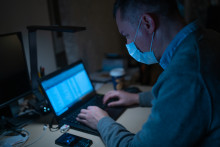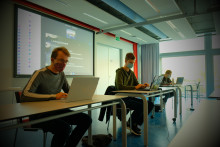The researchers at the Optical sciences group were already working with sensors to detect biomarkers of cancer and diabetes. Once the corona crisis emerged, they switched gears. ‘There was an emergency call for development of sensors for COVID-19 and I thought “hey, we can actually do that”. The decision was super-fast,’ says Garcia Blanco.
Although they didn’t receive the funding as hoped, the team got immediately to work. ‘We got some budget from the Sensing program of MESA+, so we could start straight away and we will see how far we can get. We all feel the importance of this. If we manage, it can really help people,’ continues the Adjunct Professor.
Results within ten minutes
At the moment, the scientists are fabricating a new generation of sensors that are able to detect several biomarkers at the same time. ‘We focus on detecting the coronavirus, the antibodies to the virus and other important biomarkers related to the disease,’ says Garcia Blanco.
She explains the advantages of using optical sensors compared to other (existing) methods. ‘They are very selective. They just measure what they need to measure while many of the rapid tests that are currently in the market are missing this high selectivity. They are multiplexed: you can have many channels and each channel measures a different marker. And you get the results of all the channels simultaneously. At the moment we are planning on detecting three things, but it can be scaled up as needed. And it is fast. You get results in about ten minutes from the introduction of a drop of blood.’
Future outbreaks
The development is progressing fast, says the researcher. ‘The new design is almost fabricated. We were able to accomplish that within a few weeks, which is much quicker than usual. We were able to put in a lot of resources and the team is working very hard. I’m confident it will work.’
The end goal is to create a module that could be used for testing anywhere. ‘You would get a sample, such as blood, put it on a chip and within minutes you would get a result,’ says Garcia Blanco. ‘But we are definitely not there yet. This is not something that can be ready during this pandemic, but could be very useful for future outbreaks.’








